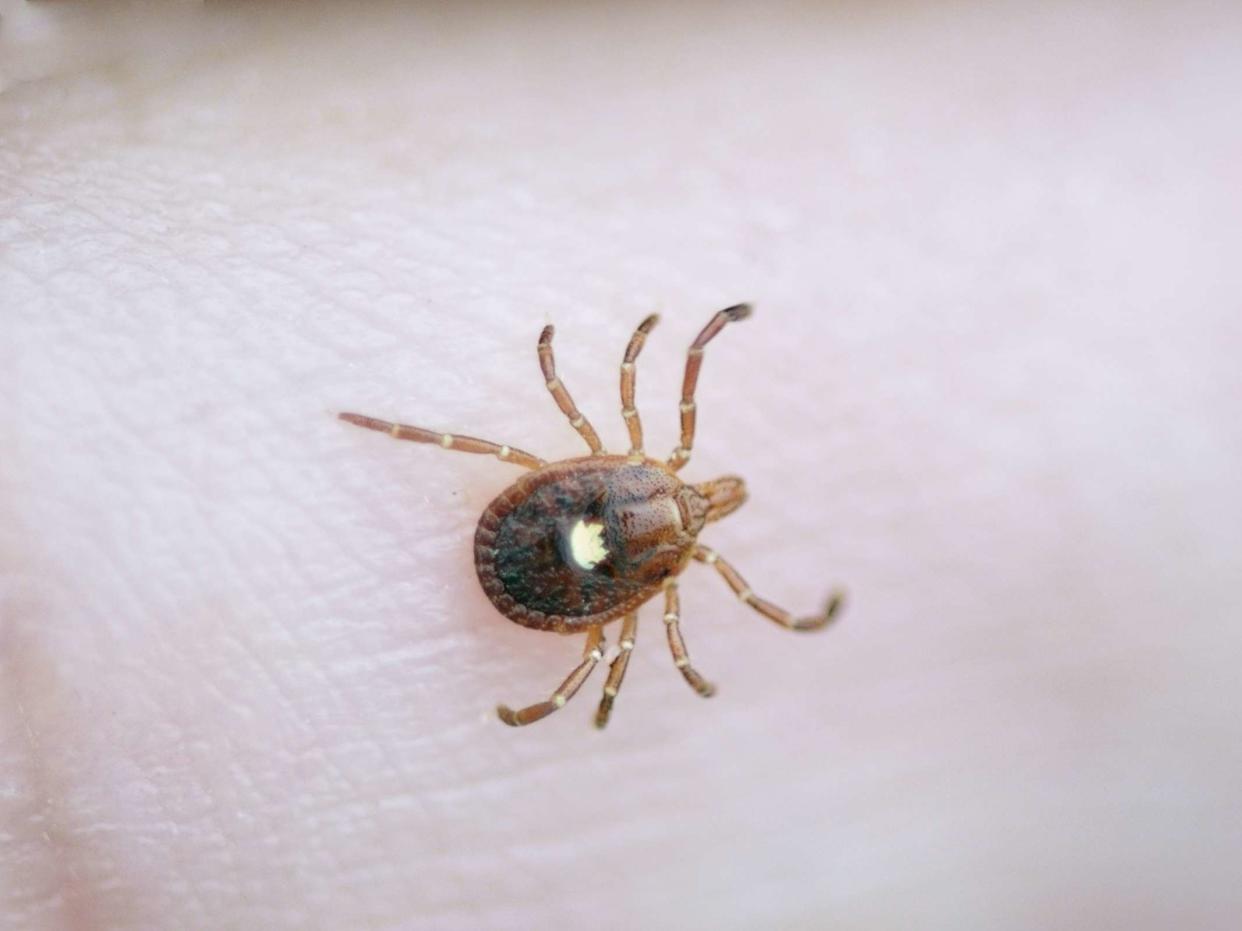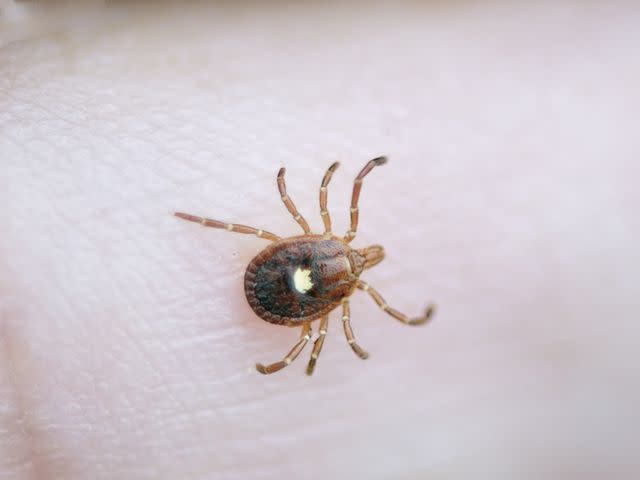Do Tick Bites Cause a Red Meat Allergy? What to Know About The Rise of Alpha Gal Syndrome

Getty Images / Joesboy
Fact checked by Sarah Scott
According to a new CDC report, alpha-gal syndrome—a red meat allergy that's kickstarted by a tick bite—is on the rise.
A majority of these cases take place in states where the lone star tick resides, primarily the southern, midwestern, and mid-Atlantic regions of the US.
Experts recommend taking precautions to avoid tick bites, like wearing pants and long-sleeved shirts, as well as using Environmental Protection Agency (EPA)-registered insect repellant.
A tick bite-related red meat allergy is an emerging public health problem in the United States, according to the Centers for Disease Control and Prevention.
Lyme disease, Rocky Mountain Spotted Fever, and Babesiosis aren’t the only health issues tick bites can cause. Two new reports from the CDC show that alpha-gal syndrome (AGS)—a red meat allergy that starts with a tick bite—may have affected as many as 450,000 people in the U.S.
Symptoms of AGS—including hives, rash, indigestion, nausea, and vomiting—occur a few hours after eating meat or dairy products. Though many cases of AGS are mild, some people may experience anaphylaxis, a life-threatening allergic reaction that affects multiple organ systems.
Between 2010 and 2022, over 110,000 suspected cases of alpha-gal syndrome were reported to the CDC—a figure that is probably lower than the reality, as many people with symptoms likely never get tested.
It's hard to see how prevalent AGS is in the United States without a national surveillance system. But experts predict AGS cases are increasing, likely due to a mix of increased awareness and emergencies.
“This is probably not a new syndrome, but a newly-recognized syndrome. We’re still learning a lot about it,” Daniel Pastula, MD, MHS, the chief of neuroinfectious diseases and global neurology at the University of Colorado School of Medicine and Colorado School of Public Health, told Health.

Getty Images / Joesboy
How Can a Tick Bite Cause a Red Meat Allergy?
According to Pastula, scientists believe that, during a tick bite, tick saliva inoculates humans with alpha-gal sugar, which can trigger an immune response where the body produces antibodies against the sugar.
This can lead to symptoms whenever a person ingests meat, such as pork, beef, mutton, lamb, venison, or another product, like gelatin, that contains alpha-gal.
The sensitivity to meat typically appears four to six weeks after the tick bite.
“In some people, the presence of alpha-gal in the blood triggers a reaction from the body's immune system, resulting in an allergic reaction to alpha-gal sugar molecules,” Bobbi Pritt, MD, FCAP, a spokesperson for the College of American Pathologists and director of the Clinical Parasitology Laboratory at Mayo Clinic, told Health.
Not everyone who gets bit by a tick and subsequently develops antibodies against alpha-gal will get AGS, said Pastula. Some people can test positive for the antibodies against alpha-gal but never develop AGS.
“Just because someone has a positive test result doesn’t mean they have the syndrome," he said. "It just means they have antibodies against it."
It’s unclear why only some people develop AGS after a tick bite, for example, or how long a tick needs to bite to trigger AGS.
“We don’t know all the details of what’s going on here,” said Pastula.
Related: 15 Facts You Must Know About Ticks and Tick-Borne Illness
AGS Cases Are on the Rise, Yet Insufficiently Diagnosed and Treated
The CDC data found that hundreds of thousands of people in the U.S. are potentially affected by AGS.
CDC researchers evaluated over 350,000 specimens that were submitted by healthcare providers from patients who had suspected cases of AGS. Over 30% of the tests submitted came back positive for antibodies against alpha-gal.
And it appears that cases are rising—the number of people who tested positive jumped from 13,371 in 2017 to 18,885 in 2021.
Ann Carpenter, DVM, MPH, Epidemic Intelligence Service Officer at the CDC and the primary author of one of the recent CDC reports, explained that in addition to more testing, the increase in AGS cases could be connected to the expanding geographic range of the lone star tick.
The lone star tick currently resides in the southern, midwestern, and mid-Atlantic United States. The CDC analysis noted New York, Virginia, and Kentucky have seen the greatest amount of AGS cases, with other states in those regions also reporting high numbers of suspected cases.
The geographic distribution of AGS cases is similar to that of ehrlichiosis, a bacterial infection transmitted by lone star ticks.
According to Carpenter, the CDC hopes the new report makes public health agencies and healthcare providers more aware of AGS hotspots, so they can treat patients accordingly.
While the main surge of AGS cases has been in areas where the lone star tick resides, 23% of the recent AGS-positive patients live in an area where the lone star tick is not usually found. A handful of those patients had reported bites from black-legged ticks.
While in other parts of the world, other tick species are associated with AGS, so far a vast majority of U.S. cases are connected to the lone star tick.
Getting Healthcare Providers Up to Speed on AGS
Despite the fact that AGS detection is increasing, many healthcare providers aren’t familiar with the syndrome.
Another CDC report surveyed 1,500 family and general practitioners, internists, pediatricians, nurse practitioners, and physician assistants across the country and found that over 40% had never heard of AGS. About a third said they weren’t confident in their ability to diagnose or treat patients with AGS.
This is the first national survey assessing healthcare professional (HCP) knowledge and practices, said Carpenter. The findings highlight the need for HCP education to improve patient care in the United States.
“Increasing healthcare provider education and awareness of AGS is needed to hasten and improve the accuracy of AGS diagnoses, patient care, and the understanding of the epidemiology of this emerging condition, and this may result in an increased identification of cases,” said Carpenter.
Preventing Tick Bites Is a Key Way to Prevent AGS
The very best way to prevent AGS is to prevent tick bites. Being prepared is a helpful step toward accomplishing this goal.
Carpenter explained that it’s crucial to use Environmental Protection Agency (EPA)-registered insect repellents when exploring the outdoors. Additionally, wearing pants and long-sleeved shirts can also help prevent bites.
Tick prevention is particularly important when spending time in tick-prone areas, such as tall grasses, shrubs, and leaf litter, said Pritt.
After your outdoor activities, shower and check your body, clothing, and gear for ticks. If you’re spending several hours outdoors, Pastula recommends intermittently scanning your body for ticks.
If you notice a tick latched to your body, use a pair of tweezers to pull it out as soon as possible. Clean the bite area with soap and water or rubbing alcohol.
If you experience AGS symptoms—an allergic reaction two to six hours after eating meat—reach out to a healthcare provider such as a primary care doctor or allergist. To make a diagnosis, a healthcare provider will need to run a blood test that looks for antibodies against alpha-gal, conduct a physical examination, and collect details about your medical history.
“People with a diagnosis of tick-borne meat allergy can then be counseled on what foods to avoid in order to prevent potentially life-threatening allergic reactions,” Pitt said.
While there is no treatment or cure, symptoms can be prevented by avoiding meat, dairy, and other products with alpha-gal.
For some patients, avoiding tick bites for up to five years may lead to a decline in antibodies that cause allergic reactions, said Carpenter. That said, new tick bites could reactivate AGS, and in some people, AGS may last a lifetime.
As Pastula said: “This is just another example that ticks are bad news and to avoid tick bites as much as you can."
Related: How To Get Rid of Ticks in Your Clothes
For more Health news, make sure to sign up for our newsletter!
Read the original article on Health.

